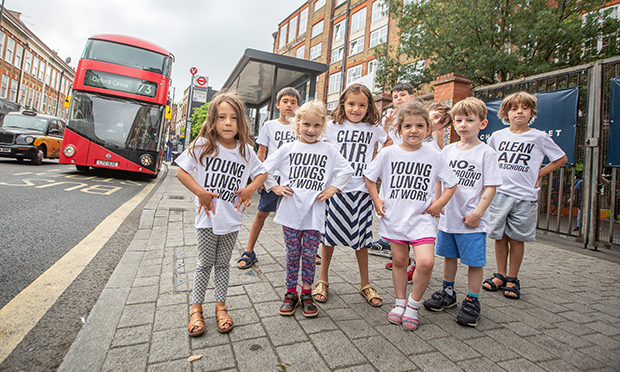Hackney Council slammed for ‘perverse’ approach to playground air pollution

Getting shirty: a group of kids make a stand earlier this year. Photograph: Jamie Smith
A campaign group has criticised Hackney Council’s “perverse” approach to air pollution limits in school playgrounds.
Hackney’s interpretation of Department for Environment, Food and Rural Affairs (Defra) air quality guidance differs from 23 other local authorities and City Hall, according to a survey conducted by the CleanAir4Schools (CA4S) campaign.
Out of two different measuring standards for air pollution set by Defra, Hackney says it uses, for school playgrounds, the limit that another council has described as less stringent and less likely to be breached.
Waltham Forest, Kingston, Enfield, Richmond, Croydon, and Haringey councils all apply both limits to school playgrounds, with campaigners stating that seventeen more Town Halls as well as the GLA are “at odds” with Hackney’s approach.
CA4S released the survey against the background of proposed road closures around Walford Road in Stoke Newington, which campaigners predict will bring a 21 per cent traffic increase past some primary schools in the area.
It comes after the council admitted in July that it underestimated in its original consultation how many more vehicles would end up using Church Street.
Hannah Worthington, a parent at William Patten primary, said: “A cynic might think Hackney is attempting to downplay school pollution to suit their road closure agenda.
“In applying less stringent legal limits for playground pollution, they are potentially exposing thousands of schoolchildren in the borough to dirtier air.
“It’s completely perverse of the council to argue school playgrounds deserve less protection than other public spaces.”
In a response to a Freedom of Information request in August, Hackney stated that it does not apply the “annual mean objective” of 40 µg/m3 of nitrogen dioxide to school playgrounds, but works from a one-hour mean, which allows for 200 µg/m3, not to be exceeded more than eighteen times per year.
However, in a response to the survey seen by the Citizen, a spokesperson for Hounslow Council said: “Following the Mayor’s programme of air quality audits in primary schools across London, including Hounslow, the consultants commissioned to carry out this work has independently endorsed the following view.
“Defra’s Air Quality Expert Group (APEG) believe that the annual mean NO2 air quality objective is more stringent than the one-hour objective in the majority of situations, and that current evidence suggests that the annual mean NO2 air quality objective is likely to be breached before the one-hour objective.”
A Hackney Council spokesperson told the Citizen in July that the annual mean objective should be applied at the façade of the school building, but a short-term objective of a one-hour mean of 200 micrograms of nitrogen dioxide per cubic metre, not to be exceeded more than 18 times a year, should be applied to playground areas.
Hackney Council had not responded to requests for a comment on the latest developments by time of going to press.
Sally Newsom, of campaign group CleanAir4Schools, said: “The annual mean applies to all locations where members of the public may be regularly exposed.
“Children at William Patten spend an average of three hours per day outside (sometimes more), five days a week, 190 days per year for seven or eight years. If that does not constitute ‘regular’ exposure, it would be difficult to know what does.
“Children are particularly vulnerable to the effects of air pollution. It is completely unethical of a council to argue that children don’t deserve a high level of protection while they are at school.”
